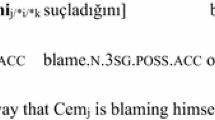Abstract
This study examines the effect of non-sentential context prosody pattern on lexical activation in Persian. For this purpose a questionnaire including target and non-target words is used. The target words are homographs with two possible stress patterns belonging to different syntactic categories. Participants are asked to read out the words aloud and note the first word that comes to their mind. The results show that by reading the target words, both meanings of the target words are activated in mind and the prosodic pattern of the non-sentential preceding context does not affect the activation of the other stress pattern meaning. This result suggests that the metrical prosodic pattern of non-sentential context is not a strong constraint to determine which meaning of the target word must be activated. The experiment also illustrates that the stress pattern used to read the target words does not necessarily matches the stress pattern of the target word which relates to the written word. These findings confirm Swinney (Verb Learn Verb Behav 18:645–665, 1979) and Elston-Güttler and Friederici’s (J Mem Lang 52(2):256–283, 2005) finding that both meanings of an ambiguous word are accessed at the first stage. This study shows that in lack of semantic context, Persian natives behave homographs as ambiguous words and there is no bias towards preferring one meaning over another.

Similar content being viewed by others
References
Amini, A. (1997). On stress in Persian. Toronto Working Papers in Linguistics, 16(1), 1–20.
Brown, M., Salverda, A. P., Dilley, L. C., & Tanenhaus, M. K. (2011). Expectations from preceding prosody influence segmentation in online sentence processing. Psychonomic Bulletin and Review, 18, 1189–1196.
Cooper, N., Cutler, A., & Wales, R. (2002). Constraints of lexical atress on lexical access in English: Evidence from native and non-native listeners. Language and Speech, 45(3), 207–228.
Couper-Kuhlen, E. (1993). English speech rhythm: Form and function in everyday verb interaction. Amsterdam: John Benjamins.
Cutler, A. (1986). Forbear is a homophone: Lexical prosody does not constrain lexical access. Language and Speech, 29, 201–220.
Cutler, A., & Donselaar, W. (2001). Voornam is not (really) a homophone: Lexical prosody and lexical access in Dutch. Language and Speech, 44(2), 171–195.
Cutler, A., & Pasveer, D. (2006). Explaining cross-linguistic differences in effects of lexical stress on spoken-word recognition. In R. Hoffmann, & H. Mixdorff (Eds.), Proceedings of speech prosody (Vol. 40, pp. 237–240).
Dilley, L., & McAuley, J. (2008). Distal prosodic context affects word segmentation and lexical processing. Journal of Memory and Language, 59, 291–311.
Dilley, L., & Pitt, M. (2010). Altering context speech rate can cause words to appear or disappear. Psychological Science, 21, 1664–1670.
Dilley, L., Mattys, S., & Vinke, L. (2010). Potent prosody: Comparing the effects of distal prosody, proximal prosody, and semantic context on word segmentation. Journal of Memory and Language, 63, 274–294.
Elston-Güttler, K. E., & Friederici, A. D. (2005). Native and L2 processing of homonyms in sentential context. Journal of Memory and Language, 52(2), 256–283.
Ferguson, Ch A. (1957). Word stress in Persian. Language, 33, 123–135.
Fitzsimons, M., Sheahan, N., & Staunton, H. (2001). Gender and the integration of acoustic dimensions of prosody: Implications for clinical studies. Brain and Language, 78(1), 94–108.
Fox, R. A., & Unkefer, J. (1985). The effect of lexical status on the perception of tone. Journal of Chinese Linguistics, 12, 67–90.
Kahnemuyipour, A. (2003). Syntactic categories and Persian stress. Natural Language and Linguistic Theory, 21(2), 333–379.
Lazard, G. (1992). A grammar of contemporary Persian, Mazda, Costa Mesa, Califomia. Translated from French by Shirley Lyons.
Lehiste, I. (1977). Isochrony reconsidered. Journal of Phonetics, 5, 253–263.
Lucas, M. M. (1987). Frequency effects on the processing of ambiguous words in sentence contexts. Language and Speech, 30, 25–46.
Mahootian, Sh. (1997). Persian. London: Routledge.
Pierrehumbert, J. (2000). Tonal elements and their alignment. In M. Horne (Ed.), Prosody: Theory and experiment (pp. 11–36). Dordrecht: Kluwer Academic Publishers.
Raithel, V., & Hielscher-Fastabend, M. (2004). Emotional and linguistic perception of prosody. Folia Phoniatrica et Logopaedica, 56(1), 7–13.
Sekiguchi, T., & Nakajima, Y. (1999). The use of lexical prosody for lexical access of the Japanese language. Journal of Psycholinguistic Research, 28, 439–454.
Simpson, G. (1981). Meaning dominance and semantic context in the processing of lexical ambiguity. Journal of Verbal Learning and Verbal Behaviour, 20, 120–136.
Simpson, G. B., & Krueger, M. A. (1991). Selective access of homograph meanings in sentence context. Journal of Memory and Language, 30(6), 627–643.
Swinney, D. A. (1979). Lexical access during sentence comprehension (re)consideration of context effects. Verb Learning and Verb Behavior, 18, 645–665.
Tabossi, P. (1988). Accessing lexical ambiguity in different types of sentential contexts. Journal of Memory and Language, 27, 324–340.
van der Hulst, H. (1999). Word prosodic systems in the languages of Europe. Berlin: Mouton de Gruyter.
Author information
Authors and Affiliations
Corresponding author
Rights and permissions
About this article
Cite this article
Feizabadi, P.S., Bijankhan, M. The Effect of Non-sentential Context Prosody on Homographs’ Lexical Activation in Persian. J Psycholinguist Res 44, 831–838 (2015). https://doi.org/10.1007/s10936-014-9324-4
Published:
Issue Date:
DOI: https://doi.org/10.1007/s10936-014-9324-4




